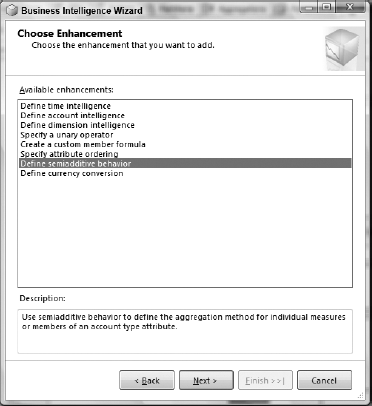9.7. Adding Intelligence to the Cube
Similar to adding intelligence to dimensions (which you learned about in Chapter 8), you can add intelligence to the cube. Figure 9-48 shows the various enhancements that can be done to a cube using the Business Intelligence Wizard. You have learned most of these enhancements in earlier chapters. In this chapter you learn the enhancements used to define and understand semi-additive behavior as well as defining currency conversion whenever fact data needs to be converted to appropriate local currency.
Figure 9.48. Figure 9-48

9.7.1. Semi-Additive Measures
Semi-additive measures are measures whose data is not aggregated as a sum or a count over the various levels of a hierarchy. The semi-additive aggregate functions for measures are ByAccount, AverageOfChildren, FirstChild, LastChild, FirstNonEmpty, LastNonEmpty, and None. For example, assume you have a Time hierarchy and the measure Sales Value to be rolled up as an average of the sales of its children. Assume the levels in the Time hierarchy are Year, Half Year, Quarter, Month, and Date. If you have a member Quarter 1 of the year 2004 whose children are months July, August, and September, then the value for Quarter 1 will be the average of the sales values for the three months.
Using the Business Intelligence Wizard you can change the behavior of the Aggregation Function of various measures ...
Get Professional Microsoft® SQL Server® Analysis Services 2008 with MDX now with the O’Reilly learning platform.
O’Reilly members experience books, live events, courses curated by job role, and more from O’Reilly and nearly 200 top publishers.

